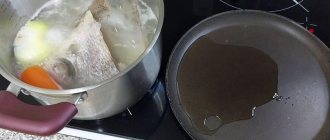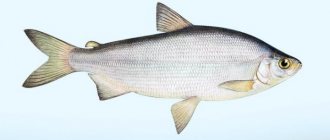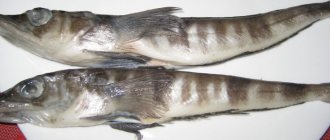Salted and smoked fish
- You can try it like in the cartoon “Well, wait a minute!” bend the dried fish or tap it on the table , but this is unlikely to bring the desired result. Therefore, we try the most common method among lovers of dried fish: you need to wrap the dried fish in a damp cloth, add milk and let it stand for several hours in the refrigerator.
- To prevent dried and dried fish from losing their taste and at the same time becoming soft, you need to do the following:
- Boil water in a saucepan
- Place the fish there for 15-20 minutes
- Remove from water
- Wrap in a kitchen towel and a plastic bag
- Place on a hot radiator or in a warm place for 1-1.5 hours
The towel in which the fish was wrapped will absorb excess moisture and the carcass will become softer.
If these manipulations are done with several fish, they can later also be wrapped in cloth and cellophane and placed in the freezer. After a week, the fish will become even softer, and at the same time remain edible.
- There is an option using a double boiler. To turn a fish from a piece of wood back into a fish, you need to cut it into portioned pieces. Lay gauze in several layers on a mesh for a steamer, and place the fish on it, also cover with gauze on top. Steam for an hour. After this, the fish will become not only soft, but also very tasty.
- An oven will also work to revive dried fish . First, you need to rinse the fish, then wrap it in foil, adding a small amount of water, and put it in the oven for 30-40 minutes. The fish will be steamed a little and it will turn out soft.
- Another interesting option for softening a wooden fish. For this you will need wet rice. You need to bury the dried fish in it and leave it in a cool place, maybe in the refrigerator, overnight. The fish will absorb moisture from the rice and soften it.
- You can not only replenish dried fish with moisture, but also give it a new taste. First you need to cut it into small pieces 1 cm thick . Next, prepare the so-called marinade: 50-100 grams of vinegar per 1 liter of boiled water, add 10 black peppercorns and 2-3 tablespoons of mustard. After coating the fish with marinade, you need to put it in the refrigerator for a couple of days. After this procedure, the fish will become not just soft, but juicy and aromatic.
We recommend reading: If you over-salt the Black Mushrooms
Eating wooden ram or pike is a dubious pleasure. To give it a second life, you can use the above methods, or experiment and invent your own, unique way!
The towel in which the fish was wrapped will absorb excess moisture and the carcass will become softer.
Storage
The conditions for storing dried fish are, in general, simple; all that remains is to choose the appropriate method. There are several options.
Shed or crawl space
Specially equipped premises, treated with anti-mold and pest control agents, are ideal for storing not only dried fish, but also other supplies, such as canned vegetables or fruit and berry preparations. To prevent the fish from drying out, they are wrapped in clean paper (not newspaper!) one at a time if they are large, or several small fish at a time.
Such packages can be hung on wire hooks or strung on a string. At the temperature and humidity indicated above, dried fish can be stored in this form for four to six months, but before eating it, it is still worth carrying out a visual inspection.
A wooden box or basket is also suitable for storing fish in an underground or closet. The container should be wrapped and covered with paper or double gauze. You can wrap the fish in paper, as described above, or you can simply alternate paper and fish layers, filling the container.
It is important that the room is ventilated, this will avoid the appearance of mold and musty smell. Under such conditions, a small amount of fish supplies will be preserved even in a simple linen bag.
Storage methods in the apartment
When you have neither a shed nor a closet at your disposal, how to store dried fish at home? For example, is it possible to hang fish garlands on the balcony? For a long time - unlikely. The temperature and humidity outside the window are unstable, and it is also too light there.
Of course, you can use wrapping paper again, but you should leave the dried catch on the balcony only in the cool season, when the temperature does not rise above +10˚C. Otherwise, the shelf life of the fish is reduced to a month. Of course, the balcony must be glazed.
Dried fish is not the same as dried fish, although they are often confused, and is considered a semi-finished product.
Fridge
In a refrigerator with a constant temperature from 0 to +10˚C, fish, carefully wrapped in paper, will quietly lie for up to six months. In this case, paper packaging is needed not only to preserve this product, but also to prevent the other contents of the refrigerator from becoming saturated with fish spirit. The fate of dairy products or desserts will be especially sad if their proximity to fish turns out to be too close.
Freezer
The shelf life of dried fish when frozen increases to a year. Paper comes into play again. It is better to pack in such portions that their size corresponds to one snack and re-freezing is not required.
In a vacuum
Some people are extremely sensitive to odors, especially when it comes to food, and therefore do not risk placing dried fish in the refrigerator.
They can proceed as follows: place a suitable number of fish and a burning candle in a clean and dry glass jar, and seal the jar with a tight lid. When the oxygen in the jar burns out, a vacuum will form there, the light will go out, and the peculiar “canned food” will need to be put away in a dark, cool place. Two to three months of storage are provided.
Important: You should never put dried fish in a plastic bag, as it will spoil very quickly!
Every lover of this snack knows what proper dried fish should taste like. This is a natural and truly healthy product.
To dry the catch, sometimes they don’t even use salt, or they salt it for only a short time and then don’t resort to soaking. In addition, the drying and drying processes differ in duration. Drying takes only a few days, but traditional cold drying can take weeks.
Not every type of fish turns out tasty when dried. For this method of preparation, products with medium fat content are most suitable. Then the meat will be dry, soft and evenly salted.
How to soften dried dried fish (ram)?
Otherwise, grandfather no longer has teeth to gnaw on it.
RAM
You can take a thin cellophane bag, wrap your fish and put it in the refrigerator under the freezer for a day or two. The fish will become not only softer, but also tastier. You can wrap it in damp newspaper and put it in the refrigerator again.
Another option is to put it in wet rice for the whole night. Wet the rice thoroughly, bury your salted fish in it and leave it in a cool place, preferably again in the refrigerator. And if the fish is very dry, then you need to wrap it in wet gauze for at least four hours.
You can take a thin cellophane bag, wrap your fish and put it in the refrigerator under the freezer for a day or two. The fish will become not only softer, but also tastier. You can wrap it in damp newspaper and put it in the refrigerator again.
Where to store dried fish
It is best to store ram at home in special packaging, since at low humidity it loses weight, and at high humidity it becomes moldy. If salted fish is stored in the open air for a long time, the fish oil contained in it will begin to oxidize, giving the ram an unpleasant taste.
For long-term storage of the battering ram, it must be kept in a cool place with a temperature of 3-8 degrees and a relative humidity of 70-80%. In special packaging, fish can be stored for almost a year.
It is best to use corrugated cardboard, wooden boxes, matting, and craft packaging as special packaging for proper storage of dried fish. You need to understand that thin fabric or paper can be pierced by the sharp protrusions of the fish. One of the best packaging is considered to be kraft paper coated on one side with polyethylene. In it, salted dried fish is stored for 8-10 months without losing its consumer qualities. In a bag of matting, the shelf life is reduced to 2-3 months.
We recommend reading: Mixing Store-Bought Mastic
You can store dried fish at home in the refrigerator. It is well preserved in areas with temperatures up to +4, but in order for the ram to be preserved longer, it is greased with oil, preferably olive oil, placed in glass jars and stored in the refrigerator. You can simply wrap the fish in thick paper and wrap it in plastic wrap.
Dried ram requires storage at a relative humidity of 70-80% and at a temperature of no more than 8°C.
Storing dried fish at home - how to do it correctly
Long-term storage of dried fish is always aimed not only at preserving the so-called presentation of the product, but also at ensuring that the fish remains tasty. A dried carcass differs from a dried carcass in that its meat is softer and more elastic, it is easier to chew and does not break when bent.
Such fish has a strong smell and, due to its saltiness, absorbs other odors well, which creates additional difficulties associated with commercial proximity. In other words, a delicacy can give off its smell to other products and absorb foreign aromas.
In this article we will tell you how to store dried fish at home so that it retains its physical and taste properties.
You need to pour a small amount of salt into the bottom of the jar, and then do not lay the fish too tightly (large carcasses are best cut into pieces).
Drying various types of fish
Vobla. Fresh fish is threaded with a metal needle through the eyes onto thick yarn in 2, 4, 6, 8, 10 or more pieces. The ends of the yarn are tied together, after which the fish is salted in bundles (sharps). First, brine from the previous salting of the fish, or brine, is poured into a salting container (without leaks). The fish is placed in the prepared bowl, and when it begins to protrude slightly from the brine, sprinkle with salt. The lower layers of fish are salted less, and the upper layers are salted more than the middle layers. The upper bundles of the roach are covered with a 1–1.5 cm layer of salt. In this way, mixed salting of the roach is carried out. 12–14% of the weight of the fish is consumed for salting. Small roach is salted in two days, and large roach in 5–6 days. If the salting dish is deep, then for better salting the fish in the dish is mixed, trying to lift the lower layers up and lower the upper layers down. Fish, as they say, is “turned over”: large fish - 1-2 days before the end of salting, and small and medium fish - 12 hours before the end of salting.
Normally salted fish has a compacted back, the meat (when cut) is dark gray in color, and the caviar is yellowish-red. Salted fish is washed well in fresh water, clearing it of mucus and undissolved salt that has coagulated on the surface. The fish are then hung on poles in the air for drying. The bundles are hung on the pole so that on both sides there is an equal number of fish, which should not be crowded and hang in two tiers. But if there is an abundance of fish or a lack of poles, or in order to save space, the fish can be placed on poles and in several tiers. If there are no poles for drying, the fish can also be hung on a string, stretched, for example, at the eaves of a house or between some stable supports.
The roach is dried for 2–3 weeks, depending on the size of the fish and the weather. The readiness of the fish is determined as follows: the back of the finished dried fish is shrunken, the meat is elastic-hard, when cut it has an even pinkish-yellow color, and the caviar is orange-red. You can also cook dried ram, roach, Siberian sorog, Aral roach, saberfish, crucian carp, shemai, vimba and other fish. In a similar way, they dry pike perch, bream, pike, carp, that is, larger fish, which must be gutted before salting, removing the entrails. There are 2 or 4 fish per bunch, and no more than six of medium size. Fish is salted either by mixed or dry salting. Fattier fish (bream) are salted and cooled with ice; in this case, more salt is taken. Salting lasts 5–7 days, and fish drying lasts 20–25 or more days.
The best quality dried fish is obtained in the spring, since at this time there are usually clear sunny days and moderate winds. Fish is dried very well - the meat of fatty fish acquires a special taste and aroma, and in skinny fish, such as pike, pike perch, it is well dried and becomes shelf stable.











